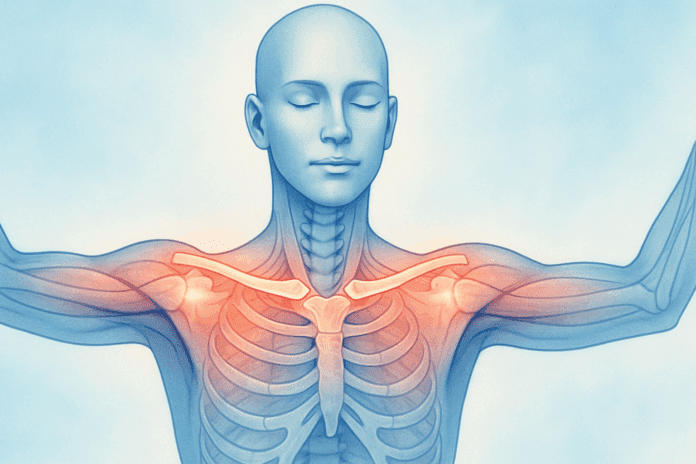The human shoulder complex is a marvel of anatomical engineering. It provides an extraordinary range of motion that allows us to lift, rotate, push, and pull with finesse. At the heart of this mobility lies a small but vital structure—the clavicle, or collarbone. Although often overlooked, the clavicle plays a crucial role in maintaining healthy shoulder mechanics and posture. Supporting the arm and acting as a strut between the sternum and the scapula, the clavicle is a structural and functional anchor for many upper body movements. As such, targeted clavicle stretches and collarbone stretching exercises can help improve shoulder flexibility, alleviate tension, and support long-term postural alignment.
You may also like : Best Stretches for Sore Legs and Tight Thigh Muscles: How to Relieve Upper Leg Pain Safely and Naturally
When mobility in the shoulder becomes compromised, whether from poor posture, injury, repetitive use, or muscular imbalances, the structures surrounding the clavicle often tighten. This stiffness can lead to dysfunction not only in the shoulders but also in the neck, upper back, and chest. Fortunately, consistent stretching focused on the collarbone area can restore balance, increase joint range of motion, and even reduce the risk of future injury. This article explores the best clavicle and collarbone stretches designed to promote shoulder mobility and postural integrity, grounded in anatomical insight and evidence-informed strategies.

Understanding the Function of the Clavicle and Its Role in Shoulder Mechanics
Before diving into stretching techniques, it’s important to understand the anatomical significance of the clavicle and its interaction with surrounding structures. The clavicle serves as a connection between the axial skeleton and the upper limb, articulating medially with the sternum and laterally with the acromion of the scapula. It helps maintain the position of the scapula so that the arm can hang freely, and it also transmits mechanical force from the upper limb to the trunk.
When the clavicle becomes restricted due to tight muscles such as the subclavius, pectoralis major, or upper trapezius, movement across the shoulder girdle can become dysfunctional. These muscular imbalances often stem from forward head posture, prolonged sitting, or training routines that overemphasize pushing motions without sufficient counterbalancing exercises. Targeted collarbone stretches can address these muscular restrictions, improve shoulder blade mechanics, and enhance the biomechanics of the entire upper body.
In addition to structural support, the clavicle plays a key role in neuromuscular coordination. Nerves and blood vessels that serve the arm pass beneath the clavicle, making it essential to preserve optimal spacing and mobility in this region. Stretching and mobility exercises that engage this area with care and consistency can help maintain proper neural function and reduce the risk of compression-related issues like thoracic outlet syndrome.
Why Clavicle Stretches Are Essential for Shoulder Health and Posture
Clavicle and collarbone stretching exercises aren’t just about loosening tight muscles; they address broader biomechanical relationships that impact the entire upper body. Shoulder stiffness and postural collapse often begin subtly, manifesting as tension across the front of the chest or a rounding of the shoulders. Over time, these imbalances can exacerbate neck discomfort, contribute to headaches, and even interfere with breathing patterns.
In many modern lifestyles dominated by computer use, driving, and phone scrolling, the shoulders become habitually rounded, and the clavicle is pulled forward and down. This not only reduces the range of motion in the glenohumeral joint but also strains the cervical spine. Incorporating clavicle stretches into a regular routine can help reverse these postural tendencies by lengthening shortened anterior muscles and allowing the scapula to reposition naturally. As mobility is restored, the rib cage can expand more freely, diaphragmatic breathing becomes more efficient, and tension in the upper traps and levator scapulae can begin to dissipate.
Importantly, collarbone stretches can also improve the proprioceptive feedback of the shoulder girdle. By enhancing awareness of posture and movement patterns, these stretches help retrain the nervous system to support healthier alignment. This can be particularly valuable for athletes, dancers, and anyone recovering from upper limb injuries, as it fosters a more integrated and responsive movement strategy.
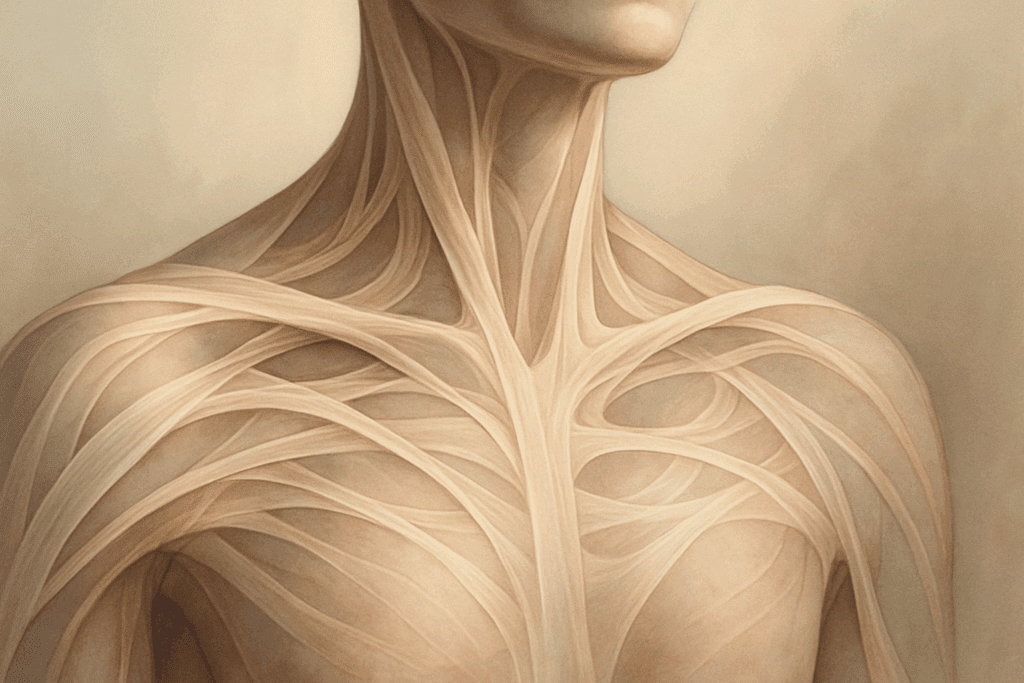
The Fascial Network and Its Influence on the Collarbone Area
Fascia, the connective tissue that surrounds muscles, bones, and organs, plays a key role in the flexibility and mobility of the upper body. While often overlooked in conventional fitness approaches, the fascial system is increasingly recognized as central to biomechanical health. The fascia surrounding the clavicle connects not only to local muscles like the sternocleidomastoid, pectoralis minor, and subclavius but also forms part of longer fascial chains that extend into the neck, spine, and even the lower limbs.
When fascial adhesions or restrictions develop—often due to sedentary behavior, repetitive strain, or injury—they can alter the gliding properties of the clavicle and reduce shoulder mobility. Clavicle and collarbone stretches performed with slow, deliberate intention can help rehydrate fascia and restore its elasticity. Techniques such as myofascial release, foam rolling, and even manual therapy from trained professionals can amplify the benefits of stretching by addressing the connective tissue component. When fascia becomes more pliable, not only does the range of motion improve, but proprioception—the body’s ability to sense its position in space—also becomes more accurate. This means better posture, smoother movements, and a reduced likelihood of strain.
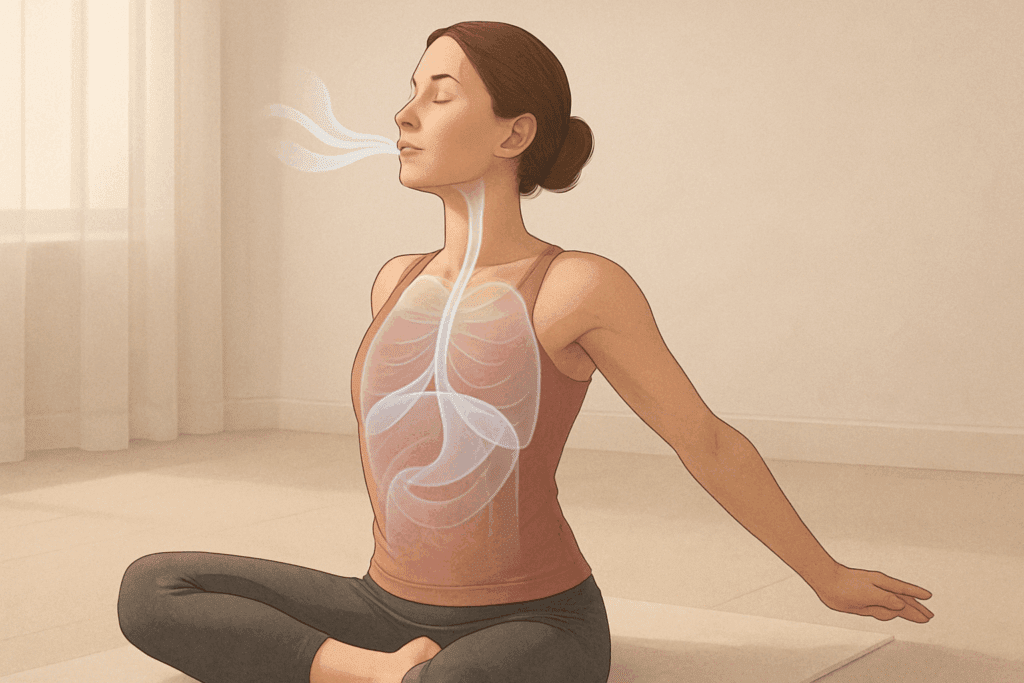
The Breath-Posture Connection and Its Role in Clavicle Stretching
Another often overlooked factor in shoulder and clavicle mobility is the role of breath. The clavicle rises and falls subtly with every inhalation and exhalation. The upper ribs, sternum, and associated musculature—including the scalene muscles and intercostals—respond dynamically to breathing patterns. When someone breathes shallowly, particularly using upper chest breathing instead of diaphragmatic expansion, the muscles around the collarbone can become chronically tight.
Clavicle stretches that are synchronized with controlled breathing can yield superior results compared to stretches performed in isolation. For example, incorporating slow nasal breathing during a doorway chest stretch not only deepens the stretch but also signals the parasympathetic nervous system to relax. This can make the tissues more receptive to elongation. Over time, retraining the breath to originate from the diaphragm and expand the lower ribs can release tension from the accessory breathing muscles—many of which attach near the clavicle. Thus, the breath serves not only as a facilitator of stretching but as a key agent in the restoration of balance across the shoulder girdle.
How Emotional Stress and Somatic Tension Affect the Clavicle Region
The shoulders are a common repository for emotional stress, often expressed through tightened trapezius muscles, hunched posture, and restricted breathing. The clavicle, which sits at the top of the thoracic cage, becomes a structural witness to these stress patterns. Over time, unaddressed emotional tension can become embedded in the tissues themselves, a phenomenon known as somatic memory.
Clavicle stretches can offer more than biomechanical release—they can also act as a form of somatic unwinding. Practicing these stretches in a quiet environment, with attention to internal sensations and emotional responses, can lead to the gentle release of held stress. This process doesn’t require psychological interpretation but benefits greatly from a nonjudgmental awareness of the body. When the collarbone region is given space to move and breathe, many individuals report a surprising sense of emotional lightness or catharsis, demonstrating the profound link between body and mind.
Yoga-based collar bone stretching exercises often incorporate these principles, blending breath, movement, and mindfulness to foster emotional and physical integration. Practices such as restorative yoga, yin yoga, or trauma-informed movement therapy provide safe and effective contexts for exploring the emotional dimensions of clavicle mobility. This holistic approach enhances the overall impact of stretching by addressing both the visible and invisible contributors to tension and restriction.
How to Safely Stretch the Clavicle and Collarbone Region
Stretching the clavicle area requires both precision and mindfulness. Unlike large muscle groups such as the hamstrings or quadriceps, the muscles and fascia around the collarbone are intricate and interconnected. Overstretching or using aggressive techniques can irritate the brachial plexus or compromise nearby vascular structures. Therefore, safety and gradual progression should always be the priority when implementing clavicle and collarbone stretches.
Begin each session with a gentle warm-up to increase circulation and prepare the tissues for elongation. Arm circles, scapular shrugs, and light chest openers can effectively prime the area. Once warmed up, stretches should be held for 20 to 60 seconds, depending on tolerance and experience level. Breath control is essential—slow, diaphragmatic breathing can help relax the nervous system and deepen the stretch safely. As always, if any tingling, numbness, or sharp pain occurs, discontinue the stretch and consult a healthcare professional.
Integrating collar bone stretching exercises into a broader mobility or rehabilitation plan can also enhance long-term outcomes. These stretches pair well with strengthening exercises for the rotator cuff and scapular stabilizers, which help support the structural integrity of the shoulder complex. Stretching alone may not resolve all issues, but as part of a balanced routine, it can be transformative for postural health and function.
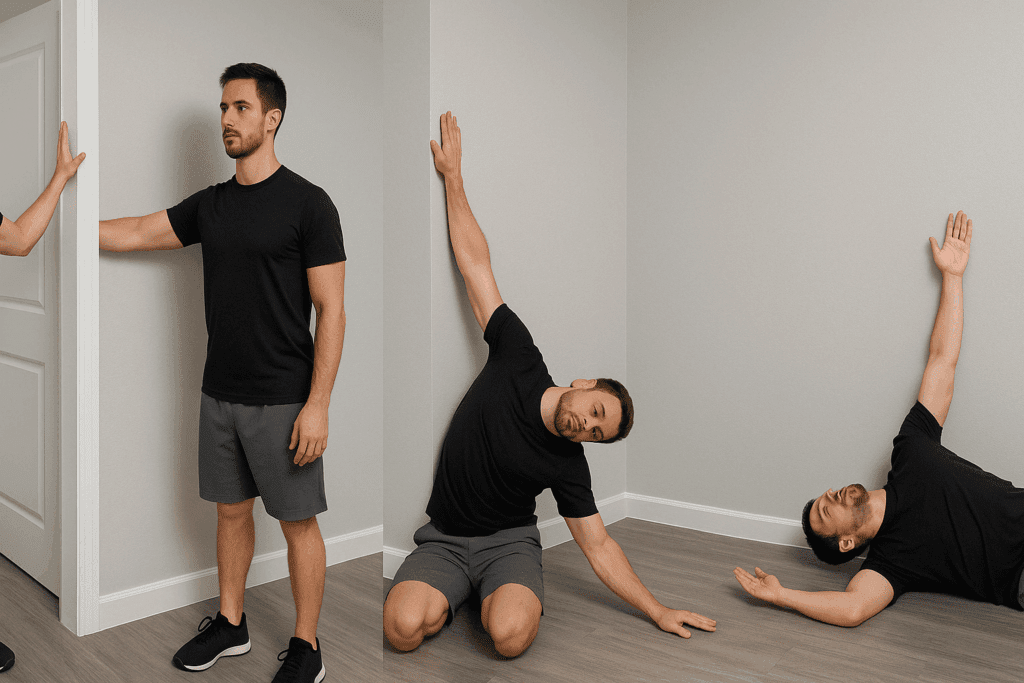
Effective Clavicle and Collarbone Stretches to Improve Shoulder Mobility
Several effective stretches can directly target the muscles and fascia surrounding the clavicle. One of the most accessible is the doorway chest stretch. Standing in a doorway, place your forearms on either side of the frame with your elbows at shoulder height. Step forward gently and allow the chest and collarbone region to open. This stretch elongates the pectoralis major and minor, which often contribute to clavicle protraction and shoulder internal rotation.
Another powerful yet gentle movement is the wall-assisted shoulder extension. Stand facing away from a wall with your palms resting against it, arms extended behind you. Slowly walk forward or lean into the stretch, keeping the chest lifted. This opens the anterior deltoid and sternoclavicular area, improving flexibility along the front of the shoulder girdle. The stretch should feel expansive rather than straining, and care should be taken to avoid excessive lumbar extension.
Seated or standing thoracic extensions can also help mobilize the region around the collarbone. Sitting tall, interlace your fingers behind your head and gently arch your upper spine backward while keeping the elbows wide. This movement supports thoracic extension and encourages the clavicle to lift and reposition naturally. It also integrates spinal mobility with shoulder opening, which is essential for functional posture.
Another excellent technique is the supine floor angel. Lying on your back with your knees bent and feet flat, place your arms in a goalpost position. Slowly slide your arms up and down against the floor, maintaining contact throughout. This stretch activates the scapular stabilizers while lengthening the chest and shoulder capsule, promoting balanced shoulder mechanics. The floor angel is particularly useful for those who need to integrate strength and mobility in one movement.
Lastly, the elevated shoulder stretch using a stable surface, such as a table or bench, can be a game-changer for tight collarbone areas. Rest your forearms or elbows on the surface, sink your chest downward, and allow the shoulder blades to glide together. This passive stretch facilitates elongation in the subclavius and upper pectorals while promoting proper scapular movement.
Collar Bone Stretching Exercises for Postural Alignment and Daily Function
While static stretching is beneficial, incorporating dynamic and functional collar bone stretching exercises can enhance posture and overall movement quality. For example, resistance band pull-aparts, when performed with an emphasis on scapular retraction, can help strengthen the muscles that oppose clavicle tension. By actively engaging the rhomboids and mid-trapezius, this movement counteracts forward shoulder drift and reinforces correct shoulder blade positioning.
Arm swings with controlled range and thoracic rotation offer another opportunity to dynamically mobilize the collarbone area. These movements simulate real-world tasks and athletic motions, encouraging coordination between the torso and shoulder girdle. When performed with awareness, they help reset the neuromuscular pathways that govern postural stability.
Yoga-inspired stretches such as extended puppy pose or modified upward-facing dog can also provide deep anterior chain opening. These positions lengthen the front of the chest and shoulders while encouraging spinal extension and diaphragmatic breathing. Practiced regularly, they can lead to lasting improvements in postural alignment and shoulder openness.
Incorporating mindful breathwork into collarbone stretches further enhances their effectiveness. Slow nasal inhalations that expand the rib cage can increase tissue pliability and promote parasympathetic nervous system activation. This reduces chronic muscle tension and facilitates better integration of the stretch into the body’s movement vocabulary.
Finally, pairing clavicle stretches with consistent ergonomic adjustments in daily life—such as raising computer monitors to eye level, adjusting chair support, or setting reminders to stretch—ensures that gains made during stretching sessions are maintained. Sustainable change is rooted not only in corrective exercise but also in cultivating body awareness throughout the day.
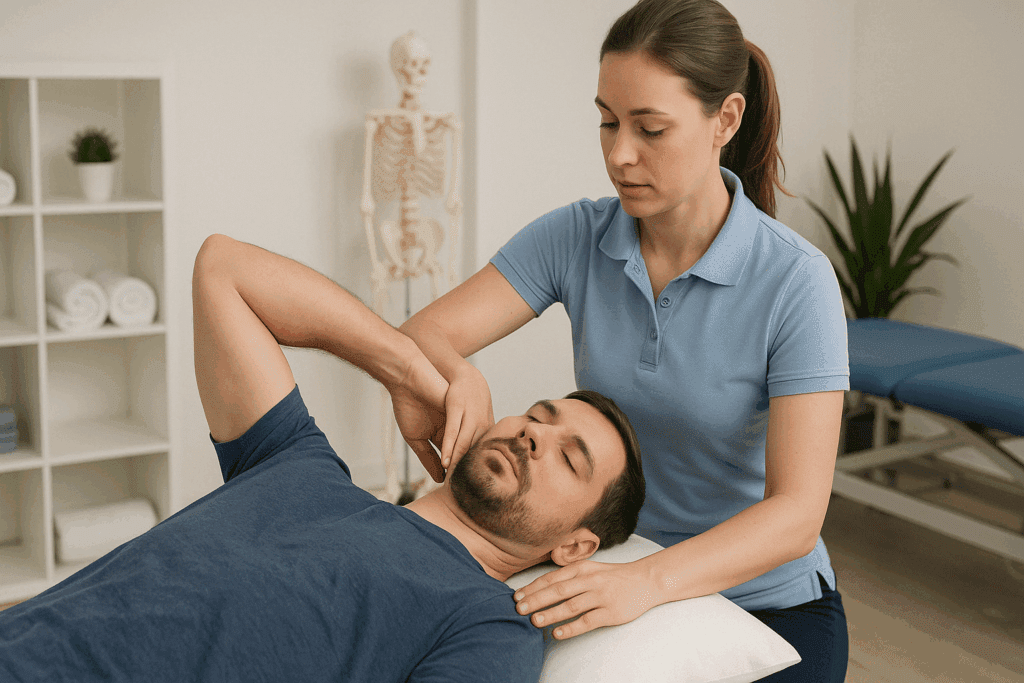
Clavicle Stretches in Rehabilitation and Injury Prevention
Clavicle and collarbone stretches have significant utility in rehabilitation settings, especially following shoulder surgeries, fractures, or chronic overuse injuries. As individuals recover from immobilization or trauma, reintroducing mobility to the clavicular area must be done gradually and under clinical guidance. Early passive range-of-motion exercises can eventually progress into active-assisted and then fully active stretches targeting the collarbone region.
For individuals with thoracic outlet syndrome or postural strain syndromes, these stretches can alleviate compression in the neurovascular bundle that runs beneath the clavicle. By improving spacing and muscle balance, stretching can reduce symptoms such as numbness, tingling, or weakness in the arms. It is essential, however, to monitor these responses closely and collaborate with a physical therapist or medical provider when integrating these movements into a therapeutic program.
Athletes, particularly swimmers, baseball players, and weightlifters, frequently place heavy demands on the shoulder complex. For them, collar bone stretching exercises play a preventative role, maintaining functional range and protecting against repetitive strain. Even recreational exercisers benefit from incorporating these stretches into warm-up and cool-down routines, as they help offset the repetitive nature of many fitness activities.
As we age, maintaining shoulder mobility becomes increasingly important for independence and daily function. Simple tasks like reaching overhead, fastening a seatbelt, or lifting objects can become challenging if the shoulder girdle loses flexibility. Regular clavicle stretches can be a powerful tool in preserving functional autonomy and preventing falls or compensatory injuries related to postural collapse.
Ultimately, the incorporation of clavicle stretches should be viewed not as a temporary fix but as a lifelong movement practice. Just as brushing your teeth supports oral hygiene, stretching the collarbone region supports musculoskeletal hygiene, allowing the body to function with greater ease, grace, and resilience.

Age-Related Changes and How Stretching Can Counteract Them
As individuals age, several changes occur that can compromise shoulder and clavicle function. These include reduced collagen elasticity, muscle atrophy, joint degeneration, and decreased proprioception. The clavicle may also experience subtle alterations in alignment due to spinal curvature, decreased activity levels, and cumulative stress on the musculoskeletal system.
However, regular collar bone stretching exercises can act as a countermeasure to these age-related declines. Gentle, progressive stretching helps maintain joint range of motion, improves circulation, and preserves the integrity of connective tissue. When paired with light resistance training and balance work, these stretches can enhance functional independence and reduce the risk of falls or shoulder injuries.
Stretching also stimulates mechanoreceptors in the fascia and muscles, sending signals to the brain that help maintain neural maps for movement. This sensory input is especially important in older adults, as it supports coordination and spatial awareness. Thus, clavicle stretches become not only a means of enhancing flexibility but also a tool for preserving cognitive-motor function across the lifespan.
Frequently Asked Questions: Clavicle and Collarbone Stretches for Shoulder Mobility and Posture
1. How do clavicle stretches influence upper body strength training routines?
Clavicle stretches are a powerful adjunct to strength training, particularly for athletes who perform frequent overhead or pushing movements. By improving mobility in the collarbone region, these stretches enhance scapular retraction and shoulder elevation—both critical components in exercises like overhead presses, pull-ups, and bench presses. Without adequate mobility, the shoulder complex can adopt compensatory mechanics that reduce power output or increase injury risk. Adding collar bone stretching exercises into warm-ups and cooldowns can improve muscle fiber recruitment patterns by ensuring optimal joint alignment. This allows for more efficient load distribution during strength training and supports long-term structural balance.
2. Can collarbone stretches help reduce the risk of nerve compression in the upper body?
Yes, one of the lesser-known benefits of collarbone stretches is their potential to reduce tension around the brachial plexus and subclavian vessels. These neural and vascular structures pass beneath the clavicle and can become compressed due to tight musculature, such as the subclavius or scalenes. Chronic compression may contribute to symptoms of thoracic outlet syndrome, which include numbness, tingling, or weakness in the arms. Incorporating gentle clavicle stretches as part of a preventative routine can help alleviate muscular tension and preserve the space around these sensitive anatomical pathways. Over time, such stretches may improve circulation and nerve conduction, supporting healthier function throughout the upper limbs.
3. How do clavicle stretches affect postural habits formed during adolescence?
Adolescence is a critical time for posture development, as growth spurts and sedentary habits can lead to structural imbalances. If left unaddressed, these patterns often solidify into adulthood and manifest as rounded shoulders or a forward head position. Integrating collar bone stretching exercises early on can help lengthen shortened anterior muscles while encouraging more balanced spinal alignment. These movements can also raise somatic awareness, teaching adolescents how to identify and correct posture deviations before they become chronic. In this way, clavicle stretches can serve as a proactive strategy for supporting lifelong musculoskeletal health, especially in an increasingly screen-centric culture.
4. What’s the difference between active and passive collarbone stretches, and when should each be used?
Active clavicle stretches involve engaging muscles while simultaneously lengthening them, which helps reinforce neuromuscular control and stability. For instance, performing a stretch where you retract your shoulder blades while reaching behind your back engages stabilizers while opening the chest. Passive collarbone stretches, on the other hand, involve external support—such as using a doorway or lying on a foam roller—allowing gravity or props to facilitate the stretch. Passive stretching is generally better suited for post-workout recovery or days focused on relaxation, while active stretching can be integrated into dynamic warm-ups or rehabilitation protocols. Alternating between these approaches ensures a well-rounded mobility routine that promotes both flexibility and functional control of the shoulder girdle.
5. How can collar bone stretching exercises be adapted for individuals recovering from surgery or injury?
Post-surgical or post-injury rehabilitation requires a highly individualized approach, and clavicle stretches must be modified to prioritize safety and tissue healing. During early phases of recovery, isometric holds and gentle range-of-motion exercises may be more appropriate than full stretching. As healing progresses, controlled collarbone stretches with minimal load can help reduce scar tissue adhesions and reintroduce mobility. It’s essential that these movements are performed under clinical supervision to prevent overstretching or irritation of vulnerable structures. When appropriately applied, these stretches can play a vital role in restoring shoulder mechanics and reestablishing functional independence.
6. Are there any psychological benefits associated with regular clavicle and collarbone stretching?
Absolutely. While often overlooked, there’s a strong connection between emotional well-being and physical posture. The clavicle region is closely linked with stress-related muscular tension, especially in the upper trapezius and sternocleidomastoid muscles. Practicing clavicle stretches can stimulate the parasympathetic nervous system, particularly when paired with breathwork and mindful awareness. Many individuals report reduced anxiety, improved mood, and a greater sense of groundedness after consistent collar bone stretching exercises. These benefits may be attributed to both the physical release of stored tension and the psychological impact of intentionally creating space within the body.
7. Can clavicle stretches improve athletic performance in sports that involve throwing or swimming?
Yes, clavicle and collarbone stretches can significantly benefit athletes involved in sports that rely on explosive or repetitive upper-body movements. In swimmers, for instance, the collarbone’s position influences scapular motion and stroke efficiency. Tightness in the anterior chest and shoulder can lead to compensatory movement patterns that waste energy and strain the rotator cuff. Likewise, in throwing sports such as baseball or javelin, shoulder integrity is critical for both power and injury prevention. Incorporating clavicle stretches into pre-competition routines can enhance range of motion, improve biomechanics, and optimize kinetic chain efficiency—resulting in more effective performance and reduced risk of overuse injuries.
8. How do collarbone stretches interact with respiratory function and lung expansion?
The clavicle sits just above the upper lobes of the lungs and moves slightly during each breath cycle. When the muscles around the collarbone become tight, they can restrict the upper rib cage’s ability to expand, limiting lung capacity and promoting shallow breathing. Practicing clavicle stretches not only restores mobility in the chest wall but also facilitates deeper, more efficient respiratory patterns. Over time, this can improve oxygenation and support endurance, particularly in aerobic activities. Additionally, integrating breath-focused collarbone stretches into your routine can be particularly beneficial for singers, wind instrument players, and individuals with asthma or postural breathing restrictions.
9. What are the long-term structural effects of consistent collar bone stretching exercises?
With consistent practice, collar bone stretching exercises can produce long-term changes in muscle length, joint alignment, and even fascial architecture. Regular stretching promotes collagen remodeling in connective tissue, which enhances elasticity and reduces the risk of fibrosis or contracture. These changes can shift the resting posture of the shoulders and spine, creating a more upright and open stance. Over time, individuals may notice improvements not only in flexibility but also in body awareness, coordination, and balance. This structural realignment also reduces mechanical load on the cervical and thoracic spine, helping to prevent degenerative changes associated with poor posture.
10. Are there any emerging techniques or tools that enhance the effectiveness of clavicle stretches?
Several emerging modalities can amplify the benefits of traditional clavicle stretches. Percussive therapy devices, such as massage guns, can be used on the pectorals or upper traps prior to stretching to enhance tissue pliability. Neuromuscular electrical stimulation (NMES) has also been used to activate deep stabilizers that support clavicle alignment. Additionally, some therapists incorporate cupping or instrument-assisted soft tissue mobilization to release fascial adhesions in the collarbone region. Mobility balls, stretch straps, and posture trainers are increasingly popular tools that allow users to safely explore greater ranges of motion during collarbone stretches. These innovations can personalize and deepen the impact of stretching routines, especially for individuals with specific performance or rehabilitation goals.
Conclusion: The Lasting Benefits of Collarbone Stretches for Mobility and Posture
In a world that constantly pulls our bodies forward—toward screens, steering wheels, and downward glances—reclaiming balance through clavicle and collarbone stretches is both an act of self-care and a scientifically sound strategy for long-term health. These stretching techniques provide more than just temporary relief. They realign the posture, reeducate the nervous system, and restore functional freedom to the shoulder complex.
Clavicle stretches and collar bone stretching exercises offer a low-cost, accessible way to counteract the musculoskeletal consequences of modern life. Whether used for daily maintenance, athletic performance, or post-injury recovery, these movements have the power to transform how we carry ourselves—literally and figuratively. By integrating them consistently and mindfully, individuals can expect improvements in shoulder mobility, reduced tension, and a greater sense of body awareness.
With time and commitment, these stretches become more than a physical intervention; they represent a shift toward a more upright, open, and integrated way of moving through the world. As with any health practice, the key lies in consistency, mindfulness, and gradual progression. When approached with respect for the body’s unique rhythms and needs, clavicle and collarbone stretches can become a cornerstone of vibrant, pain-free living well into the future.
Further Reading:
Stretch of the Week: Seated Clavicle Stretch

